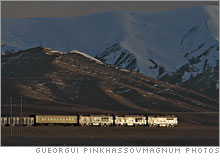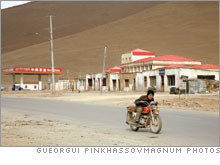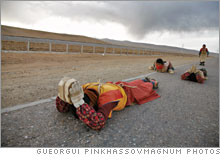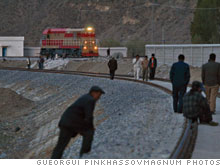|
Next stop, Lhasa
It took 40 years and more than $4 billion to build a railway across Tibet's plateau. The train to the top of the world will change this magical place forever.
(FORTUNE Magazine) - Pemba Norbu's house is built of mud and logs and covered with woven twigs. The dirt floor is meticulously swept, but smoke billows from a wood-fired hotplate, smudging the low ceiling. Until recently his only brush with modernity meant hitching a ride to Lhasa on a flatbed diesel truck to sell yak butter from his herd. "When the train first moved across the new tracks, it was deafening. Our house began to shake," Norbu says over a cup of Tibetan tea with butter, pointing to a three-inch-wide crack that shoots along one wall like an oak branch. "We thought it would collapse. But we have nowhere else to go."
Fifty feet above Norbu's house, up a steep slope, are two shiny standard-gauge steel rails. Norbu--who wouldn't give his real name because Tibetans have been punished for talking to reporters--has never used a telephone, let alone ridden on a train. Yet this summer passengers will gaze down on his thatched roof from behind the thick glass of an oxygen-enriched train, sipping tea served by waitresses, talking on cellphones, and marveling at the way of life of a plateau herdsman. Mao's strategy
The completion of China's first railroad to Tibet marks the achievement of a goal set by Mao Zedong more than 40 years ago as part of a strategy to dominate the region and integrate it more successfully with China. Indeed, Beijing's unrelenting pursuit of this roughly $4.2 billion project was more like an obsession: It is the highest, most complex, and, on a per-mile basis--because half of it is built on permafrost--one of the most expensive railway engineering feats of its kind. To build it China reached out to Western companies such as Bombardier, General Electric, and Nortel for the communications network and locomotives capable of hauling at high altitudes. And in five years of construction the project has brought a wave of globalization to what had been one of the most secluded places on earth. China's Tibet Autonomous Region is an area almost the size of Texas, California, and New York combined. It is a barren, inhospitable, and sometimes stunning land, where wide valleys filled with grasslands and nomadic herders rise up to crevassed sheets of glacier pouring off jagged mountain ridges. These glaciers are the headwaters for three of the greatest rivers in the world: the Yangtze, the Yellow, and the Mekong. About 85% of Tibet's population is rural, living in mud and mortar villages like Norbu's or in simple canvas tents on the open plain. Lhasa, with 250,000 of the region's 2.7 million people, is its largest city. Many Tibetans still wish for independence; China forcefully took control of the territory in 1950, and its spiritual and political leader, the Dalai Lama, fled nine years later. But these days Chinese seem to outnumber Tibetans in Lhasa, and the casinos and slick nightclubs there reflect a rapidly changing country. In the next few weeks the Chinese Railways Ministry, which declined numerous requests for interviews over the past nine months, will soon lead several groups of journalists to Tibet to preview the train. By Chinese accounts, the rail line is an investment in a modern economy for Tibetans and all of China's rural poor. Forging tighter bonds
The country's 47,000 miles of railway barely extend beyond the eastern half of China. Officials hope that the Tibet railroad will herald trade, bring business, and allow China to take advantage of rich deposits of natural resources like gold, copper, and coal. (Xizang, the Chinese word for Tibet, means "western treasure house.") But the railroad has also become a symbol of control. It has encountered criticism from groups that fear the project will help militarize Tibet, harm the environment, and ultimately extinguish the local culture. "Like nothing else, it's going to end that sense of Tibetan separateness," says Ronald Schwartz, a Tibet expert and professor of sociology at Memorial University of Newfoundland. "Tibet will simply be the next stop on the main Chinese line." But it is climate and geography, not politics, that have made the railway so difficult to build. Between Golmud, where the new line begins, and Lhasa, 710 miles south, are a high plateau and mountain range that have long isolated Tibet. The path of least resistance climbs to 16,900 feet, 2,400 feet higher than California's Mount Whitney. It is earthquake prone--an 8.1 rocked the region in 2001--and winds whip sand and ice at 50 miles an hour, creating an ecological sandblaster that can peel the paint from vehicles and lacerate human skin. Temperatures on the plateau bottom out at 35 degrees below zero for months. As in the Arctic, much of the ground on the plateau is filled with ice. When it thaws, the ground can drop a foot, only to heave up again the next time it freezes. Over time it can move as much as 15 feet. Building a railway on such terrain is an engineering challenge, and to do it Chinese scientists had to predict the rate of climate change, then design a system that would keep the ground frozen and the train's foundation stable even if the air warmed. If they are wrong and change happens faster than they think, according to Chinese news reports, the train could be inoperable in a decade. Zhang Luxin, a chief engineer on the Tibet railway project, was 26 in 1973 when he heard a crackly radio broadcast by Mao pledging to connect China to Nepal with a railroad. Zhang, now a distinguished-looking man with cropped black hair and rimless glasses, immediately felt the patriotic pull that has come to define his generation. "There is an ancient Chinese saying," he says. " 'I spend my whole life in one battle.' " Though he had been married for just one week, Zhang left his bride in Beijing and went to Tibet, where he camped in tents and charted the rail route on foot for the next three years. He has single-mindedly dedicated his life to making the railroad a reality ever since, and--like the time he was lost in a blizzard without a map--nearly died several times in the process. The greatest challenge was figuring out how to build a fixed track on what is essentially unstable, moving ground. Rough plans for the project had been sketched out by a team of soil engineers around 1960, and Zhang, working with them, became an expert too. He and scientists at the Chinese Academy of Sciences, the government's main academic research arm, started what later became the Cold and Arid Regions Environmental and Engineering Research Institute, or Careeri, to focus on the problem of stabilizing the soil. Construction got underway in Xining, the provincial capital of Qinghai, in the 1960s, and in 1973 a half-kilometer test section of track was built high on the plateau. But the Cultural Revolution exhausted the government's treasury, and the tracks ended at the foot of the plateau in Golmud. Officially the project was halted, says Zhang, "but for all those years we never stopped working on it." While the railway languished, Zhang's institute developed expertise applicable beyond the plateau, becoming one of the world's leading soil research centers. One day in September 2000, Zhang was summoned to a meeting at the Ministry of Railways in Beijing about whether the railway would ever be built. Then-President Jiang Zemin had made the project a priority, but prospects looked bad. Dire scenarios were described--workers wouldn't be able to breathe at high altitudes; the permafrost problem might be unsolvable. Then the engineer recalls a defining moment. He stood up at the long wooden conference table and rested both palms on its surface. "The technical issues have been solved," he said. "I have been a participant and a witness for 30 years, and I promise you, it can be done." Politics are part of the equation
The announcement that the railway would go forward fueled a smoldering controversy. Supporters of Tibetan independence, both inside and outside China, feared a wave of Han migration would follow the introduction of comfortable and affordable transit across the plateau. Students picketed the two Canadian companies involved in the project. And the Dalai Lama went so far as to say the railway could be used as an instrument of cultural genocide. (He has also acknowledged there could be economic benefits.) International protests forced the end of a World Bank--China partnership on a resettlement project in Qinghai, north of the proposed railroad, after it too touched on some of the same sensitivities. Had China asked for funding for the Qinghai-Tibet railway at that point, it would have been unthinkable, says Lou Thompson, a former advisor at the bank who has played a role in lending China over $2 billion for nine other railway projects. "Obviously," he says, "the project has more than financial implications." Wang Derong, a chief government architect for China's transportation planning, doesn't dispute that view: "One of the most important reasons is political stability. We don't try to hide the purpose." The Golmud-Lhasa highway--the first major infrastructure project in the region after the Chinese revolution in 1949 --crosses the tundra like a thread dropped haphazardly on a vast landscape. It is scarcely two lanes wide, forcing passing trucks to play a tense game of chicken. For four decades it has been the primary artery into Tibet. More than 5,000 trucks travel the route each day. But it too has suffered the impact of a hostile climate and is pocked with potholes, heaving in places like a roller coaster. Despite a regrading in 2003, it was clear that trucks remained a grossly inefficient way to transport anything, even in good weather. What was less clear was how a railroad would fare any better. In May 2002, when I first visited the region, 100,000 workers from nearby Sichuan and Gansu provinces were strung out like ants along the earthen railbed that snaked along the highway. Their jobs were not technical. They broke stones with sledgehammers, shoveled gravel, and poured concrete along the embankments that in some places were 90 feet high. The workers lived in camps like the one at Tanggula, the highest point along the route. There, ramshackle huts with corrugated-tin roofing flapped noisily in the whipping wind and gave shelter to men in torn canvas shoes. They earned about $5 a day, a relatively good wage often spent on a bowl of instant noodle soup and the occasional prostitute. Workers relied on the 25 oxygen stations set up along the way and deluged medical tents with complaints of headaches and edema. Permafrost melts and refreezes
It was Zhang Luxin's team that eventually figured out how to build a railway on Tibet's permafrost--but not without driving the budget nearly 50% higher than planned. Underneath the plateau's frozen soil are columns of ice and caverns, some more than 30 feet deep. As the earth expands, the cavities fill with water. When it freezes, ice makes up as much of the earth as the soil. When the ice melts, the soil contracts and subsides, moving like a miniature tectonic plate at geologic light-speed. Railroads and oil pipelines have been built on permafrost since the early 1900s in Russia, Alaska, and Canada. But those projects--including the Russian railway that Chinese researchers modeled their engineering on--have required extensive maintenance. The Russian railway experienced a 30% failure rate, Chinese permafrost experts say, meaning that nearly a third of the track had to be reconstructed every few years. Tibet offers an odd combination of high elevation and a more temperate environment. Each summer the sun bears down on the plateau, warming it far beyond Arctic norms. And global-warming trends mean that what is frozen now may not be in 50 years. "The permafrost on the plateau has different features from other areas," says Zhao Shiyun, general manager of the Qinghai- Tibet Railway Co. "We discovered this as we worked." To avoid the kinds of problems that plagued the Russian railroad, Zhang and the Tibet team came up with an unusual and expensive solution: Refrigerate the ground to keep it frozen as the climate warms. To do this engineers used a handful of cooling methods that take advantage of natural convection cycles and draw heat out of the ground. The simplest is a stone embankment--a layer of loosely piled chunks of granite about the size of baseballs that allows enough space between the rocks for air to circulate freely. Russian researchers stumbled on the method in the 1970s after anthropologists discovered an ancient gravesite buried in the stuff in the mountains of Kazakhstan. The earth underneath had been permanently frozen several degrees below the temperature of the surrounding area. Where such a straightforward method won't work, the engineers bury ventilation pipes in the ground. In some cases the pipes simply allow the cold air to circulate underneath the railbed. In other spots, though, a pipe called a thermosiphon is sunk 30 feet into the ground and filled at the bottom with ammonia. The ammonia becomes gas at a low temperature, giving off a vapor that draws heat from the bottom of the tube and flushes it out the top, cooling at the same time. Two pipes, costing $1,000 each, are buried every four yards--one reason the Qinghai-Tibet railway cost about $6 million a mile to build, China's low labor costs notwithstanding. The methods are proven--thermosiphons are used along the Trans-Alaska pipeline--but their ability to mitigate future warming is not. "You have to combine them with a heck of a lot of design," says Douglas Goering, a professor of engineering at the University of Alaska. "I might know this cooling stick works, but how many of them do I need, and where do I place them?" These techniques addressed only part of the problem. There were long sections where the permafrost was so delicate it simply couldn't be built on. For those lengths--about 40 miles--the Careeri team suggested elevating the railway on concrete viaducts. From the highway, the seemingly endless bridges look like the Disneyland monorail running across the surface of the moon. All the permafrost engineering, and a great portion of the cost of the railway, are based on an assumption that the rate of climate change, and thus the rate that the ground will melt on the plateau, is predictable. The Lanzhou engineers modeled a two-degree Celsius change over 100 years. But their estimate allows little room for error. And it differs from another set of models, created by the Beijing Climate Center, that predict a faster rate of warming. Revamping a 1980s design
At first glance, inside a vast train factory in Qingdao, the cars that will begin taking passengers to Tibet this summer look unsophisticated and old. They are, in fact, developed from a 1980s Belgian design. They do not at all resemble the streamlined cars depicted on giant billboards that have gone up across the Tibetan countryside and on the streets of Lhasa. But beneath their pine-green skins, the 173 cars being built by Bombardier Sifang Power Transportation (or BSP, as the Canadian-Chinese joint venture is known) harbor subtle modernizations. Their undercarriages are sheathed in metal to protect them from the sandblasting effect of windblown dirt and snow. Their windows, which do not open, are double paned with pressure valves to keep them from cracking under intense barometric change. Each seat, bed, and table has an oxygen hose to assist passengers in breathing the thin air. And the electrical and communications systems--both the ones inside the cars and the external wireless ones built by Nortel--are redundant. Should a car break down in one of those storms Zhang got caught in, a mechanic could be as far as three days' drive away. "Out there, you lose something," says Nortel's vice president of international operations Scott Wickware, "and it could take days to replace it." The first test run of one of the BSP trains--nine cars with room for 930 passengers, plus three engines--got underway Feb. 5 at the factory in northeastern China. The train passed through Jinan, Xining, Golmud, and up onto the high plateau, where it turned back a few hours short of Norbu's home. Like almost everything that preceded it on this project, the test run happened far sooner than anyone expected. When Zhang got the nod to go forward in 2000, optimists promised the railway would be operational in time for the 2008 Olympics in Beijing. In the U.S. a construction project that big might have taken 15 years from start to finish. "In China things are happening in different ways than we are used to," says Amir Levin, general manager of BSP. "We discussed this train for more than a year with the plan to be online in 2007. One day I get a call, and they say, 'We changed the plan. Can you be ready a year in advance?' " In the days leading up to the announcement of the railroad's completion last October, well ahead of schedule, the project still wasn't finished. Where the track winds its way into the Lhasa valley from the west, workers scrambled to lay the final six miles of steel. On the last bridge--a grand triple-arch structure over the Kyichu River that is designed to emulate the silk scarves Tibetans place around the necks of holy lamas and temple deities--Chinese workers clambered on scaffolding. Near the last tunnel before Lhasa, the railbed was still being shaped with rock and gravel. A couple of hundred yards away, before the single track disappeared into the mouse-hole-like entrance to the Lhasa terminal, the steel ran out. The station is a large red structure, flanked by two smaller white wings, that echoes the architecture of the Potala Palace, the seventh-century marvel that sits atop a large rock outcropping above Lhasa and was home to Dalai Lamas. The station's design has infuriated many Tibetans, who say it expropriates one of their most recognized symbols to represent the joining of Tibet with the rest of China. As the scaffolding around the station came down, polished Land Cruisers and jet-black Volkswagen Passats made a show of shuttling government officials from the city center, five miles away, to the new terminal. Bridges were closed to traffic, and soldiers with machine guns stood ready to respond to any protests. In the public squares, closed-circuit cameras silently monitored the masses. But there weren't any protests. On the morning of Oct. 15 a festive multiethnic ceremony staged in front of the station was later broadcast around the country. Traditionally-dressed Tibetans danced and sang folk songs in front of politicians and officials in black suits. Starting this summer passengers will be able to buy tickets in Beijing's West Railway station to go all the way to Lhasa. The 48-hour journey will cost as little as $46. But passenger service to Lhasa is just the beginning. An agreement between an American startup called RailPartners and the Chinese government will allow service to ratchet up next July. That's when RailPartners will begin running a $1,000-a-day luxury train called the Tangula Express--complete with 100-square-foot private suites, oversized glass windows, haute cuisine, and full bathrooms. There are also plans to open high-end resorts not only in Lhasa but at five other locations along the rail route, including Damxung, a few miles from Norbu's home. "If you look at how Tibet will be with us or without us," says Josh Brookhart, the 35-year-old CEO of RailPartners, "we clearly think it will be better with us." Brookhart's project is just one sign that Tibet's tourism boom will accelerate. The 1.2 million tourists who visited Tibet last year (most of them arriving by air) were only a small slice of the 900 million tourists, mostly domestic, who traveled in China in 2005, according to Peter Wong, executive vice chairman of the China Chamber of Tourism. Wong, who operates several resorts in Qinghai, says the industry expects a huge increase in tourists next year--up to 4,000 a day are expected to arrive by train--and more as the 2008 Olympics approach. But tourism won't be enough to make the Qinghai-Tibet railway financially viable. Tibet has little in the way of manufactured goods to send by rail. And shipping minerals from Tibet to eastern industrial cities, though there is already an upsurge in mining in Tibet this year, might be prohibitively expensive. Capacity for the line is estimated at just two million tons a year, according to the World Bank's Thompson. "You can't pay off a $5 billion project with that," he says. If the $13 million annual operating profit of the Alaska Railroad is any measure, it would take 300 years to pay off the invested capital. There were reportedly disagreements over the project's financing at the start. The state-owned railway company didn't think it should have to foot the cost of construction since the government's goal is broad economic development rather than profits, Thompson says. Beijing agreed to assume the capital costs if the railway company paid the operating costs. That's not unusual in China and especially not in Tibet, where subsidies from Beijing accounted for 59% of the region's GDP in 2004 (the last year for which data are available), according to Canadian development economist Andrew Fischer, who recently published a book on the subject. But whether the railroad project will speed development of Tibet, as Beijing hopes, remains an open question. The money spent on construction, Fischer says, tends to benefit the contracting firms and their workers, who come from other parts of China. And building an expensive railroad in a region where the illiteracy rate is four times that of neighboring Sichuan province and the number of vocational schools per capita one-fourth that of the rest of China may not be the best allocation of resources. But Beijing's build-it-and-they-will-prosper approach to economic development isn't about to be derailed by such considerations. In March the government announced its 11th five-year plan, which features an extension of the Lhasa line to Shigatze, Tibet's second-largest city, and from there it will eventually be extended to the southern border. One night last fall I met with a young, well-educated Tibetan in Lhasa to hear his view on the railway. He led me through a maze of alleys, afraid to be seen talking to a foreigner. He refused to be taped and wouldn't allow me to take notes, but what he said was little different from what I heard from dozens of others. "It is not that we are against development or against a railway to Lhasa," he said, adding that in the end, it is not a question of whether the railroad will hurt or help Tibet--it will probably do both. "Given the opportunity, we may have even decided to build one ourselves." The problem, he said, is that "we never got to make that decision." Reporter associates Brenda Cherry and Zhang Dan contributed to this article.
This report was made possible by a grant from the MacArthur Foundation. |
|





